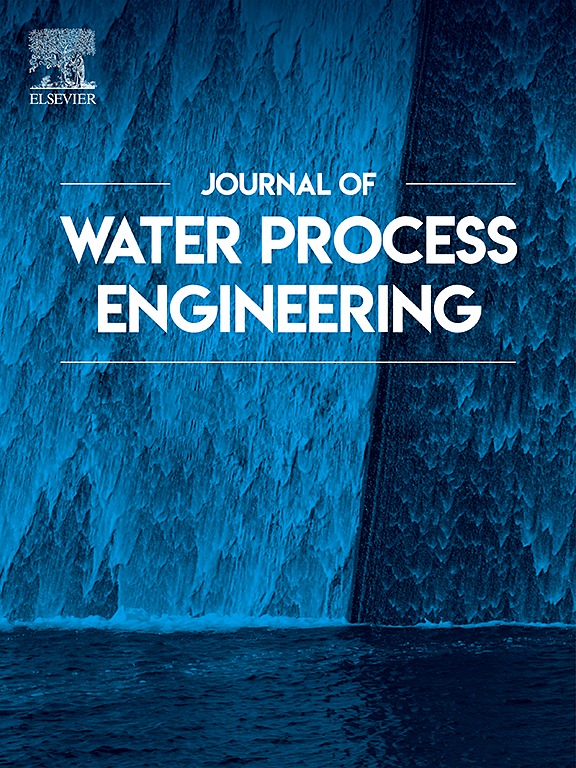垂直潜流人工湿地处理商业洗衣废水的性能:设计和运行参数的影响
IF 6.3
2区 工程技术
Q1 ENGINEERING, CHEMICAL
引用次数: 0
摘要
人工湿地(CWs)越来越多地被考虑用于处理商业洗衣厂的灰水(GW)。然而,关于操作参数和设计参数如何影响连续油管性能的信息有限。本研究旨在评估垂直潜流人工湿地(VSSFCWs)处理商业洗衣GW的性能,重点研究设计和操作参数的影响。将2台实验室规模的VSSFCWs的运行分为3个阶段,在这3个阶段中,orl逐渐升高,hrt逐渐降低。一个VSSFCW填充沸石(Zeo),而另一个使用砾石(Gra)。在第三阶段,两种系统对化学需氧量(COD)的去除率为73 - 86%,铵态氮(nh4 +-N)的去除率为72 - 84%,磷酸态磷(po4 3−-P)的去除率为68 - 89%,表明有显著改善(p <;OLR从12.3 g·COD/m2·d增加到49.9 g·COD/m2·d, HRT从10 d降低到3.5 d。在所有阶段,Zeo系统在有机物和营养物质去除方面比Gra高出19 - 33% (p <;0.05)。此外,Freundlich等温线模型显示,使用过的沸石的吸附量降低到0.004 mg/g,比对照沸石低1 ~ 5倍。这些发现强调了优化操作参数和选择合适的支持介质对商业洗衣GW有效和可持续再利用的重要性。本文章由计算机程序翻译,如有差异,请以英文原文为准。
Performance of vertical subsurface flow constructed wetlands for commercial laundry greywater treatment: Effects of design and operational parameters
Constructed wetlands (CWs) are being increasingly considered for the treatment of greywater (GW) from commercial laundry sources. However, limited information is available on how operational and design parameters influence CW performance. This study aimed to evaluate the performance of vertical subsurface flow constructed wetlands (VSSFCWs) for the treatment of commercial laundry GW with a focus on the effects of design and operational parameters. The operation of two lab-scale VSSFCWs was divided into three stages, during which ORLs progressively increased and HRTs decreased. One VSSFCW was filled with zeolite (Zeo), while the other used gravel (Gra). In Stage III, both systems achieved removal efficiencies of 73–86 % for chemical oxygen demand (COD), 72–84 % for ammonium‑nitrogen (NH₄+-N), and 68–89 % for phosphate‑phosphorus (PO₄3−-P), indicating a significant improvement (p < 0.05) as OLR increased from 12.3 to 49.9 g·COD/m2·d and HRT decreased from 10 to 3.5 days. In all stages, the Zeo system outperformed Gra by 19–33 % in terms of organic matter and nutrient removal (p < 0.05). Additionally, the Freundlich isotherm model revealed a reduction in the sorption capacity of the used zeolite to 0.004 mg/g, which was 1 to 5 times lower than the control zeolite. These findings emphasize the importance of optimizing operational parameters and selecting appropriate support media for the effective and sustainable reuse of commercial laundry GW.
求助全文
通过发布文献求助,成功后即可免费获取论文全文。
去求助
来源期刊

Journal of water process engineering
Biochemistry, Genetics and Molecular Biology-Biotechnology
CiteScore
10.70
自引率
8.60%
发文量
846
审稿时长
24 days
期刊介绍:
The Journal of Water Process Engineering aims to publish refereed, high-quality research papers with significant novelty and impact in all areas of the engineering of water and wastewater processing . Papers on advanced and novel treatment processes and technologies are particularly welcome. The Journal considers papers in areas such as nanotechnology and biotechnology applications in water, novel oxidation and separation processes, membrane processes (except those for desalination) , catalytic processes for the removal of water contaminants, sustainable processes, water reuse and recycling, water use and wastewater minimization, integrated/hybrid technology, process modeling of water treatment and novel treatment processes. Submissions on the subject of adsorbents, including standard measurements of adsorption kinetics and equilibrium will only be considered if there is a genuine case for novelty and contribution, for example highly novel, sustainable adsorbents and their use: papers on activated carbon-type materials derived from natural matter, or surfactant-modified clays and related minerals, would not fulfil this criterion. The Journal particularly welcomes contributions involving environmentally, economically and socially sustainable technology for water treatment, including those which are energy-efficient, with minimal or no chemical consumption, and capable of water recycling and reuse that minimizes the direct disposal of wastewater to the aquatic environment. Papers that describe novel ideas for solving issues related to water quality and availability are also welcome, as are those that show the transfer of techniques from other disciplines. The Journal will consider papers dealing with processes for various water matrices including drinking water (except desalination), domestic, urban and industrial wastewaters, in addition to their residues. It is expected that the journal will be of particular relevance to chemical and process engineers working in the field. The Journal welcomes Full Text papers, Short Communications, State-of-the-Art Reviews and Letters to Editors and Case Studies
 求助内容:
求助内容: 应助结果提醒方式:
应助结果提醒方式:


